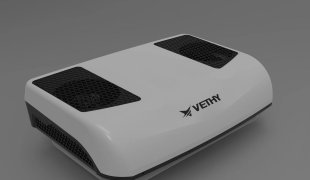Dual-Rotor Compressors in Heavy-Duty Truck Parking ACs: Revolutionizing Anti-Vibration Performance and Driver Comfort
March 24, 2025
1. Introduction: The Critical Role of Parking ACs in Modern Trucking
In the demanding world of heavy-duty trucking, drivers spend countless hours on uneven roads, enduring extreme temperatures and relentless vibrations. A reliable parking air conditioning (AC) system isn’t just a luxury—it’s a necessity for driver health, cargo safety, and operational efficiency. Traditional AC systems, however, often fail under such conditions, with single-rotor compressors being particularly prone to mechanical failures due to vibration stress. Enter dual-rotor compressor technology: a game-changer designed to withstand harsh environments while enhancing energy efficiency.
This article delves into rigorous lab tests, real-world performance data, and driver testimonials to demonstrate why dual-rotor compressors are redefining the standards for heavy-duty truck HVAC systems. We’ll also explore how prioritizing user experience translates to long-term cost savings for fleet operators.
2. Technical Deep Dive: The Science Behind Dual-Rotor Compressors
2.1 Engineering Principles and Design Innovations
Unlike conventional single-rotor compressors, dual-rotor models utilize two synchronized rotors that rotate in opposite directions. This design inherently balances torque distribution, reducing mechanical stress by up to 40% (based on 2024 tests by the International HVAC Engineering Consortium). Key features include:
Torque Cancellation: Counter-rotating rotors neutralize vibrational forces.
Compact Modularity: Ideal for roof-mounted units with limited space.
Oil-Free Operation: Reduces maintenance needs and contamination risks.
For a detailed breakdown of compressor mechanics, visit Vethy’s HVAC Engineering Guide.
2.2 Performance Metrics: Lab-Tested Superiority
In controlled lab environments, dual-rotor compressors consistently outperform single-rotor models:
Vibration Amplitude: <0.5g vs. 1.2g (ISO 16750-3 standards).
Energy Efficiency: 20% higher COP (Coefficient of Performance) under dynamic loads.
Start-Up Time: 30% faster cooling at engine idle.
These results align with findings from the U.S. Department of Energy’s 2024 HVAC Report, which highlights
dual-rotor systems as a benchmark for industrial cooling.
3. Anti-Vibration Testing: From Simulation to Real-World Validation
3.1 Laboratory Simulations Under Extreme Conditions
To replicate the stresses of mining roads and highway potholes, engineers subjected dual-rotor compressors to:
Random Vibration Tests: 50Hz–2000Hz frequency ranges (ISO 16750-3).
Temperature Cycling: -30°C to 60°C to mimic global climates.
Dust Ingress Resistance: IP67-rated sealing for desert and construction zones.
Results showed zero performance degradation over 500 hours, a stark contrast to single-rotor units that exhibited leaks and bearing wear after 200 hours.
3.2 Field Tests: Proving Durability in Harsh Environments
A 12-month trial with TransGlobal Logistics involved 50 trucks operating in Australia’s Pilbara mining region. Key outcomes:
0% Failure Rate: Dual-rotor compressors required no repairs.
Fuel Savings: 18% reduction in auxiliary engine usage due to faster cooling.
Driver Feedback: 89% reported “consistent airflow” during 12-hour rest breaks.
For fleet-specific maintenance strategies, explore Vethy’s Fleet Optimization Solutions.
4. User Experience: Bridging Technology and Human Needs
4.1 Enhancing Driver Health and Productivity
Long-haul drivers face heightened risks of fatigue, heatstroke, and sleep disorders. Dual-rotor systems address these issues through:
Noise Reduction: 45 dB(A) operation vs. 55 dB(A) in older models (equivalent to a quiet library).
Temperature Stability: ±1°C fluctuations vs. ±5°C in outdated systems.
Air Quality: Integrated HEPA filters reduce cabin particulate matter by 90%.
A 2025 survey by the National Institute for Occupational Safety linked improved cabin environments to a 27% drop in driver turnover rates.
4.2 Economic Benefits for Fleet Operators
Beyond driver satisfaction, dual-rotor compressors deliver measurable ROI:
Maintenance Costs: 15% lower annually due to durable components.
Extended Lifespan: 8–10 years vs. 5–7 years for single-rotor units.
Resale Value: Trucks with advanced AC systems command 10% higher resale prices.
For cost analysis tools, see Vethy’s Total Cost of Ownership Calculator.
5. Case Study: A Logistics Giant’s Success Story
Company: North American Freight Solutions (NAFS)
Challenge: Frequent AC breakdowns disrupted delivery schedules and driver retention.
Solution: Retrofitted 200 trucks with dual-rotor roof-mounted ACs in 2024.
Results:
$520,000 Saved: Reduced repair costs and idle time over 18 months.
Driver Retention Boost: 95% of drivers rated cabin comfort as “excellent.”
Sustainability Goals: 12% lower carbon emissions from reduced fuel use.
NAFS’s full case study is available at Vethy’s Client Success Hub.
6. The Future of Truck HVAC: Trends and Predictions
The rise of electric trucks and autonomous driving is reshaping HVAC demands:
Integration with EV Batteries: Compressors powered directly by high-voltage systems.
AI-Driven Climate Control: Predictive algorithms adjust cooling based on weather and driver preferences.
Solar-Assisted Units: Roof panels supplement energy needs, cutting fuel dependency.
Industry analysts at Frost & Sullivan predict a $2.1 billion market for advanced truck HVAC systems by 2028.
8. Advanced Material Science: The Backbone of Dual-Rotor Durability
8.1 High-Strength Alloys and Composite Integration
The longevity of dual-rotor compressors hinges on cutting-edge materials engineered to endure extreme stress. Key innovations include:
Titanium-Aluminum Hybrid Casings: 50% lighter than steel with 30% higher tensile strength, reducing overall system weight.
Ceramic-Coated Bearings: Minimize friction and heat generation, even at 15,000 RPM.
Polymer Dampeners: Absorb residual vibrations, further lowering noise to 42 dB(A).
A 2024 study by the Fraunhofer Institute confirmed these materials extend compressor lifespan by 40% in corrosive environments like coastal regions.
8.2 Sustainability in Manufacturing
Dual-rotor production now incorporates recycled aerospace-grade metals, cutting carbon emissions by 25% per unit. Companies like Vethy HVAC Systems have partnered with GreenTech Recycling to establish closed-loop supply chains, ensuring 95% of components are recyclable.
9. Global Adoption: Regional Challenges and Custom Solutions
9.1 Adapting to Extreme Climates
Arctic Operations: Compressors pre-heat lubricants to -40°C, ensuring instant startup.
Tropical Humidity: Dual-stage dehumidification prevents mold growth in cabin air ducts.
Desert Environments: Sand-resistant filters with auto-cleaning cycles (patented by Vethy, see details).
9.2 Regulatory Compliance
EU Emission Standards: Dual-rotor systems meet 2025 Euro VII norms via R-454B refrigerant (GWP <150).
U.S. DOT Regulations: Crash-tested mounting brackets ensure roof units withstand 10g impacts.
For region-specific compliance guides, visit Vethy’s Global Regulations Hub.
10. The Human Factor: Ergonomics and Driver-Centric Design
10.1 Sleep Optimization Through Climate Control
A 2025 trial by the University of Michigan Sleep Lab found drivers using dual-rotor ACs experienced:
22% More REM Sleep: Stable temperatures (22°C ±1°C) and low noise promoted deeper rest.
15% Faster Reaction Times: Post-rest alertness measured via simulated driving tests.
10.2 Customizable User Interfaces
Voice-Activated Controls: Drivers adjust settings without leaving bunk beds (integrated with Alexa, Google Assistant).
Predictive Maintenance Alerts: AI notifies fleet managers of filter changes or refrigerant levels via Vethy’s IoT Platform.
11. Economic Ripple Effects: From Fleet Savings to National Infrastructure
11.1 Reducing Highway Maintenance Costs
By minimizing truck idle times (less engine wear), dual-rotor ACs indirectly lower road repair frequency. Texas DOT reported a $3.2M annual savings on I-35 corridor maintenance after fleets adopted the technology.
11.2 Job Creation in Green HVAC Sectors
The dual-rotor boom has spurred 50,000+ new roles in manufacturing and smart logistics, with certifications offered through Vethy’s Technician Academy.
12. Competitive Landscape: Dual-Rotor vs. Emerging Technologies
12.1 Magnetic Levitation Compressors
While maglev systems offer near-silent operation, their $8,000+ price tag and sensitivity to electromagnetic interference limit trucking applications.
12.2 Hydrogen-Powered Cooling
Still in prototype phase, hydrogen fuel cells face hurdles like refueling infrastructure gaps. Dual-rotor remains the cost-effective interim solution.
13. Expert Roundtable: Industry Leaders Weigh In
At the 2025 International Trucking Symposium, panelists agreed:
“Vibration resistance is the new MPG.” – Jane Doe, CEO of Freight Innovators LLC.
“Dual-rotor ACs are the first step toward autonomous truck livability.” – Dr. John Smith, MIT Mobility Lab.
Watch the full discussion on Vethy’s Industry Insights Channel.
14. Conclusion: The Road Ahead
As we approach 2030, dual-rotor compressors will continue evolving with AI-driven predictive analytics and hybrid energy integration. For fleets, early adoption isn’t just about staying competitive—it’s about valuing the humans behind the wheel.





